Flower beds in the country: design options
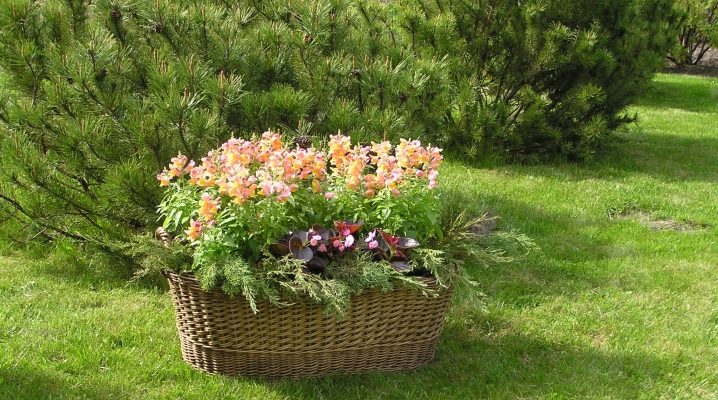
There is no happier occupation for the mistress of a summer cottage than to come up with and implement a breakdown of flower beds on it. Flowers breathe poetry into being outside the city, creating an atmosphere of celebration and joy. At the same time, it is not at all necessary to entrust the design of flower beds to a professional designer. The harmony and grace of floristic compositions can be achieved independently.
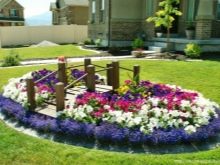
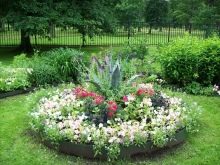
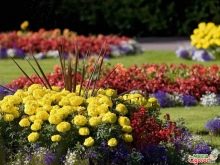
Peculiarities
When choosing the design of your flower bed, everything will depend on personal preferences and concepts of beauty and style. By the way, it is customary to call a flower bed any collection of flowers that have any shape. Some people like free landscape beds, that is, spills of flowers in the form of bright spots on a green lawn. Others prefer strict flower beds - round, elliptical or triangular.
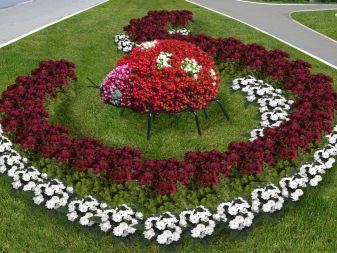
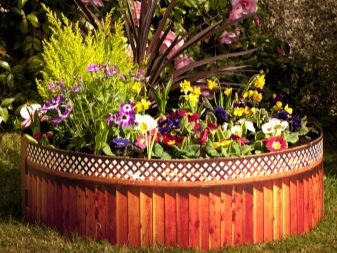
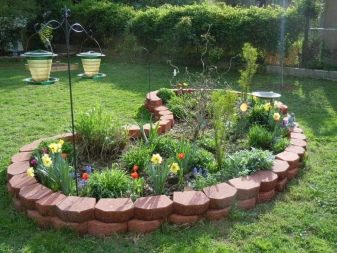
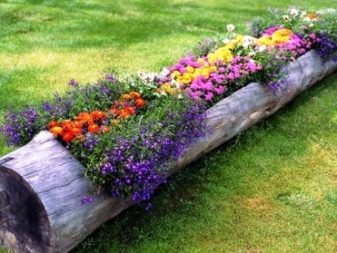
Among summer residents there are many fans and mixed options. This variety implies that the flower bed is not only flower, but also contains ornamental shrubs, conifers, and sometimes dwarf trees. Mixborders are in trend - this, one might say, flower bed along the path... Usually it is made up, playing at the height of flowers - from the smallest to the highest - a kind of elegant fence, blooming from spring to frost.
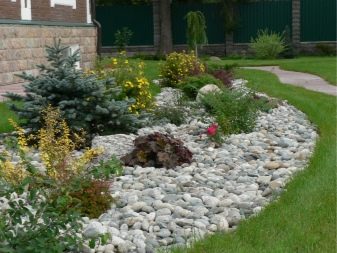
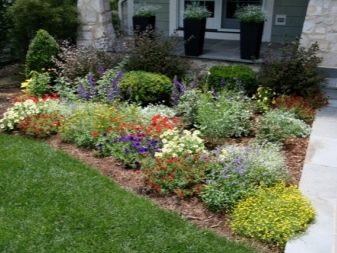

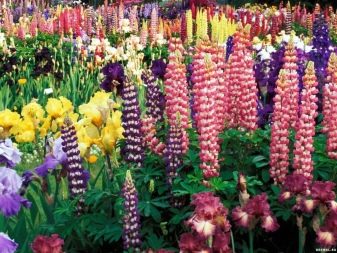
Adherents of classic flower beds usually stop at parterre - a large flower garden in the center of the garden in the form of a square or rectangle. Plants are planted in it so that a colorful, gorgeous pattern built on contrasting shades is obtained.
Those who gravitate towards the natural picture usually like tapeworms - single bushes of tall, elegant flowers, scattered carelessly towards the house and attracting attention. More and more is becoming fashionable among landscape designers and amateur summer residents discount, which is a collection of low flowers, as if running in single file in a thin strip along the path and emphasizing its ornament.

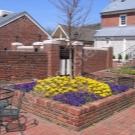
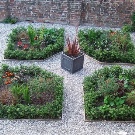
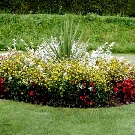

When laying out a flower bed, it is important to understand the logic of its future review. Flat beds are suitable for summer cottages with elevation differences, terraces. It is good to admire such flower beds from a bench on a hill. Vertical flower beds add seclusion and privacy to the corner of your garden. And the horizontal ones visually expand the space.

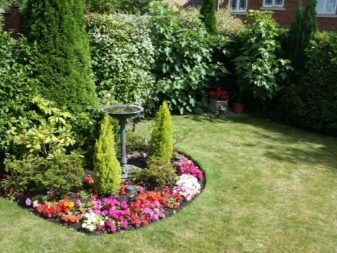
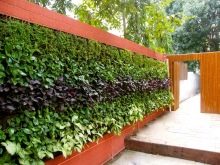
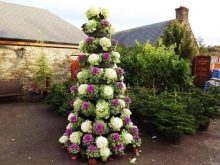
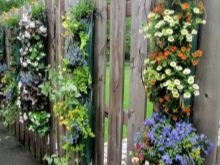
Views
Flower beds can be infinitely varied. Flower beds in stones look presentable. Natural stones either frame a round flower bed, or create several tiers, where new and new plants grow on each "floor" of the hill. The most inventive gardeners build real stone rocks on their sites, imitate the natural high-mountainous relief and "squeeze" bushes of flowers into the "crevices" between the rocks.
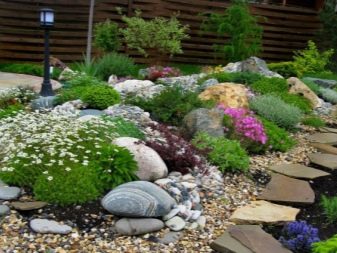
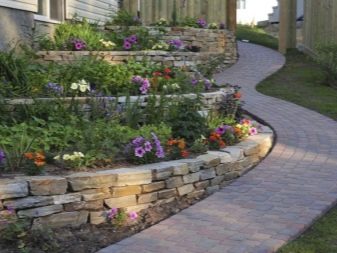


The design of the flower garden in the form of an animal silhouette will add mystery and fun to a secluded corner of the garden. For inexperienced gardeners, designers advise the so-called single-color flower beds. They have one variety of colors, and the paints are very diverse, better contrasting. You can experiment with the rose garden here.
If you have no experience at all in breaking down flower beds, stop at an ordinary petunia.
Tired of the correct forms, land owners increasingly like the so-called spontaneous summer cottages. It is just a fragrant sea of flowers without any fit whatsoever design laws.
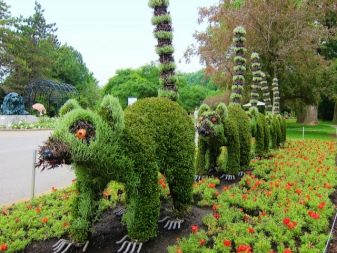


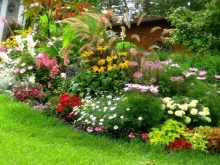

For the "professors" of gardening, we can recommend vertical flower beds - aerobatics of country design. Place large pots on top of each other or reinforce the levels of the future flower "pyramid" with a stone. Then sow different flowers for greater effect.
But you have to guess so that they turn out to be approximately the same in height. These should be plants with complex, densely packed petals. For example, begonias, some terry varieties of petunias, are generally recognized for vertical gardening.
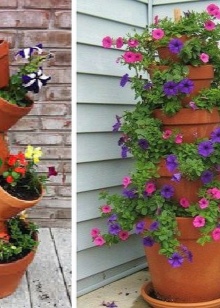

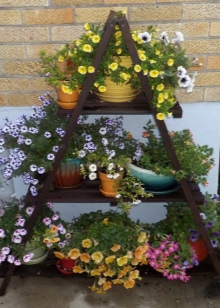
As an exotic version of a flower bed, "mountain serpentine" is suitable. It is created from stone and netting, but requires either the intervention of professionals, or serious skill in creating such an intricate design. As you "climb", you need to plant a viola, an Alpine forget-me-not, a hamerops. "Serpentine" flower bed will delight your guests.
Fans of Provence notes will like a small flower bed, broken in an old stump or in a tree cut. The brighter the petals of the flowers "knocked out" of the wooden ornament turn out to be, the more beautiful it will look.
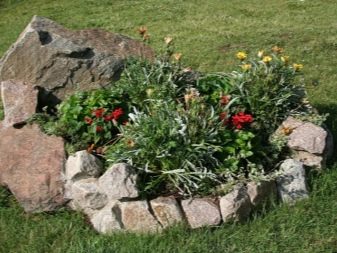
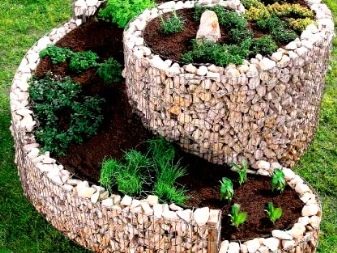
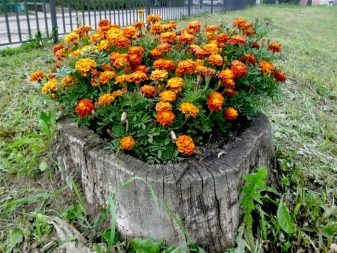
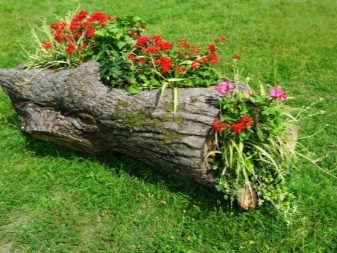
An outlandish find will turn out to be an old clay vase, a jug, from which a stream of flowers will “flow out” (undersized small plants are used).
As a basis, around which a flower arrangement appears, if desired, you can use a sundial, mirrors, arches, sculptures, topiary figures (shrubs with dense leaves cut in the form of various reliefs).
The spring flower bed of tulips, hyacinths, daffodils, crocuses looks absolutely poetic, laid out according to the principle of a "forest" lawn, that is, without observing strict configurations.
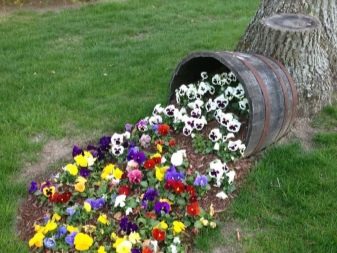
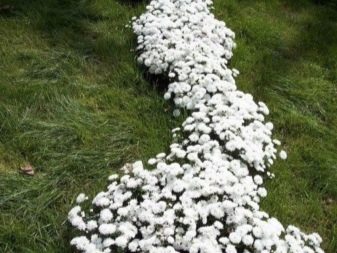
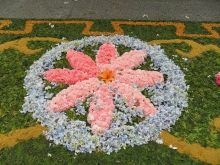
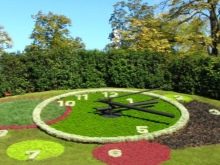

Color descriptions
Every summer resident dreams of making his flower garden look charming and elegant in spring, summer and autumn. This goal requires careful selection of flowers for the flower bed. Professionals advise to fill flower areas with not the most whimsical specimens that can overwinter without undue efforts of the gardener. For example, peonies, clematis can use their "registration" in the same place for ten years or more. Cineraria, chamomile, aquilegia, some other biennials and perennials are not capricious in this sense.
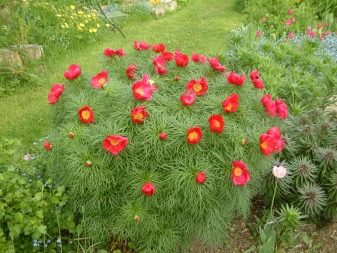
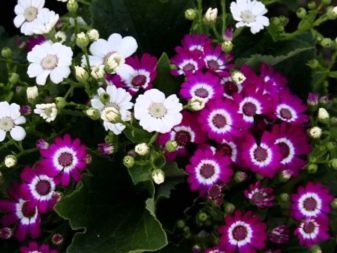
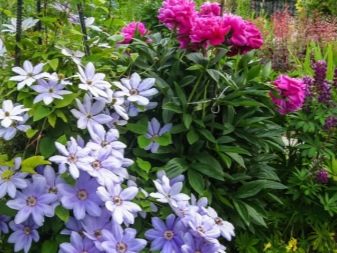
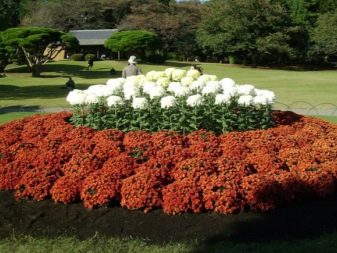
But the floristic representatives of the southern latitudes suffer greatly from the frosts of central Russia and require great attention to themselves - digging, organizing wintering on the veranda or in a pot, special insulating frames. Therefore, we will consider options for bright, spectacular-looking, but quite hardy plants. At the same time, we will select them for our oasis in such a way that flowering is not interrupted.

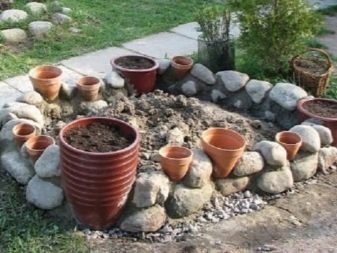
Already at the end of March, you can enjoy delicious delicate primroses: purple and golden crocuses, boiling white galanthuses, sky blue snowdrops and violets. In April, they will be replaced by a stunningly bright, incredibly fresh carpet of viola pansies.
May will illuminate the flowerbed with scarlet, pink, variegated tulips, lilac and raspberry hyacinths. Together with them, daffodils, lilies of the valley, forget-me-nots, bathing suits, daisies will seize the dominance of the flowerbed. In the middle latitudes of the country, proud irises and fiery geraniums feel great in spring.
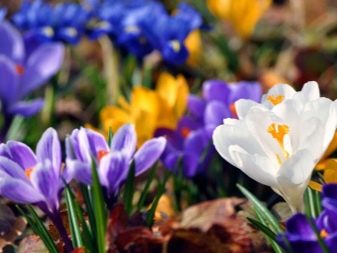
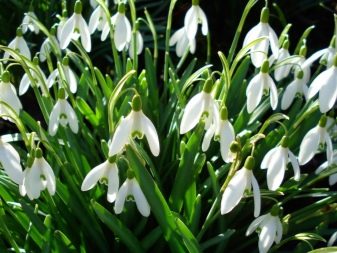
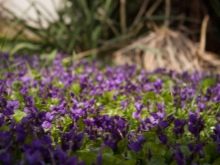
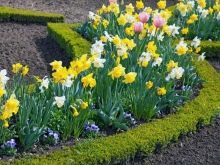
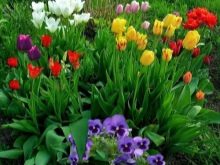
For June, prepare bells, daisies, carnations, poppies on the flowerbed. By the end of June, they will open their magnificent bouquets of lilies. They seem to cover the flowerbed with fancy fragrant domes. Lupins, delphinium look great at the beginning of summer.
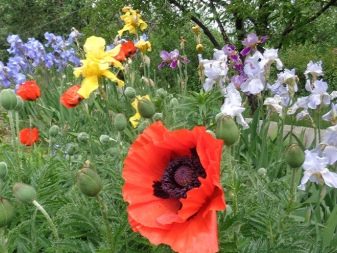
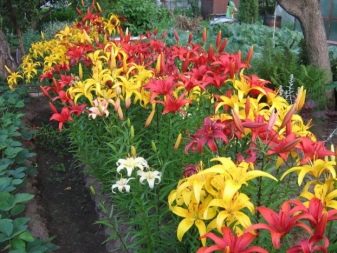
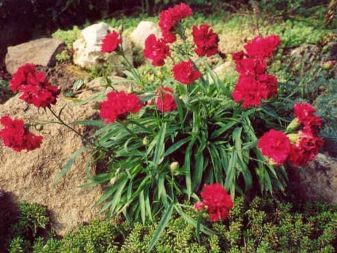
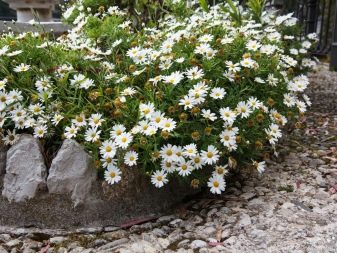
On the flower bed, give accent spots to roses - they will captivate the eyes with beautiful new buds until autumn. Petunia is ready to act as a cheerful background - this unpretentious shy woman also drives out new and new flowers all summer. In July phloxes, nasturtium, cosmeas will take over the splendor. In August, an explosion of light and grace will be presented by dahlias, astilbe, gladioli. Many summer residents are happy to include decorative sunflowers, rudbeckia, felicia, zinnias in the plans of flower beds.
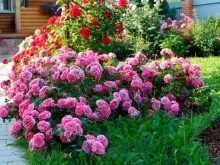


In autumn, chrysanthemums, asters, late hybrid roses come out on the "parade". Flowers look most impressive on multi-level flower beds, an alpine slide. The philosophy of their planting is as follows: background, small-flowering plants are planted in groups.
It is better to place the bright ones less often, in single specimens, so that they can "boast" with each of their petals.
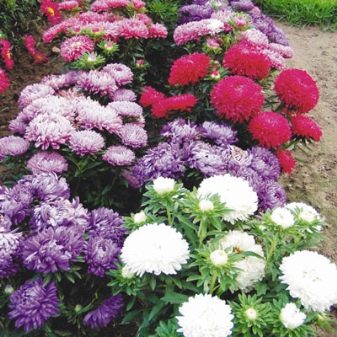

How to choose a seat?
When choosing a place for a flower bed, some points must be taken into account. The first is a vantage point. The flower garden should be clearly visible from the garden benches, from the entrance to the site, from the gazebos and, of course, from the windows of the house and from the veranda. It is also necessary to provide so that the flower bed does not cover other picturesque centers of the dacha - a fountain, a pond.
When the point of the flower bed location is more or less determined, it's time to decide where and what kind of flower "zest" you will fix. After all, it is not enough to "impose" a floristic composition on the site map and calculate a favorable view for it, you still need to think about how the flowers will be combined with the lawn and other surrounding elements.
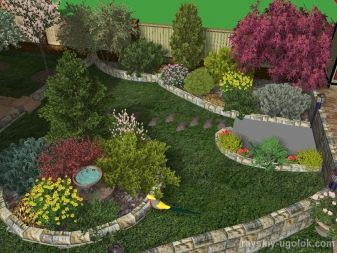

If the flower bed is programmed on an open lawn, its owners prefer to surround it with comfortable paths. The meaning is clear: it is pleasant not only to enjoy plants from afar, but also to admire them in close proximity.
You can create a flower bed on a small lawn without paths. It turns out a completely aesthetic picture, completely natural.
Only with this choice, do not forget to provide a barrier for the grass, otherwise it will spread from the lawn to the flower bed and get to the flower garden itself.
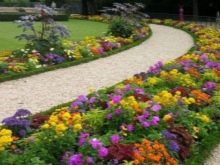
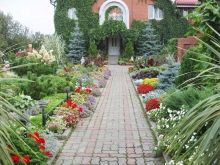

The flower beds inscribed in the so-called group plantings always look interesting. That is, on your fragrant site near the house, there are several specially placed spectacular plants to indicate color accents. To shade these "spots" or just for better zoning of group specimens, it is logical to place a small flower bed between them.
For example, you have single akalifa bushes fluffed up with pink "foam", on the contrary - large bushes of burgundy peonies. And the "dividing" element is a flower garden of small aquamarine forget-me-nots and white crocus flowers. Fantastic contrast and very gentle transition from one amazing composition to another.
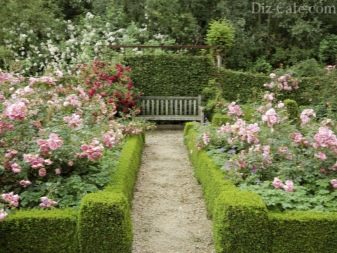
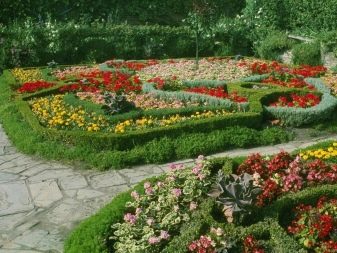
It is not difficult to come up with a good place for a vertical flower garden. A bright pergola is placed so as to cover, for example, a parking area on the central alley of the dacha. Or to separate the decorative fountain from the "primitive" barbecue.
An important condition that determines the location of the flower bed is the acidity of the soil (these characteristics should be studied in advance, since not all flowers tolerate certain soil structures), as well as the saturation of lighting.
Without sunlight, or, conversely, with direct exposure to the flower bed throughout the day, your flower garden may experience discomfort.
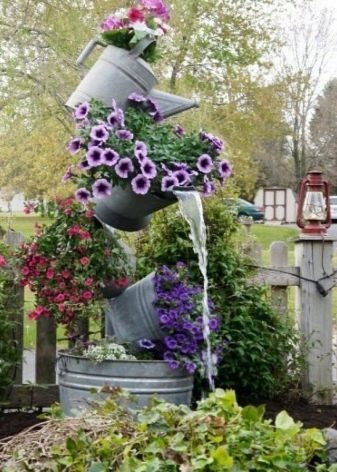
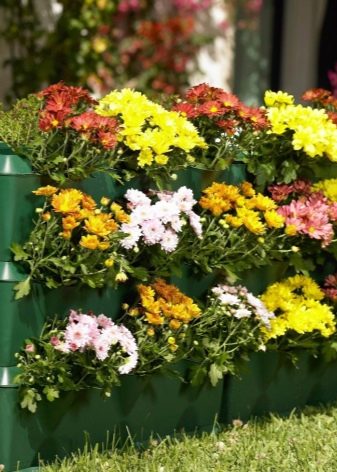
The wind rose will play its role in choosing the location of rare plants. In cold drafts with elite flower beds, it is better not to experiment.
If it is planned to place a variety of bright colors on a flowerbed, then it will fit well into a shady place, "illuminate" it with its brightness. But gardeners with a delicate taste also like monoclumba - flower beds made up of one type of plant - say, white tulips. Very original sound, but such a picture in pastel colors is absolutely necessary to "expose" to the sunto add depth to her understated colors.
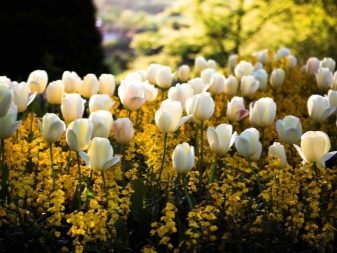
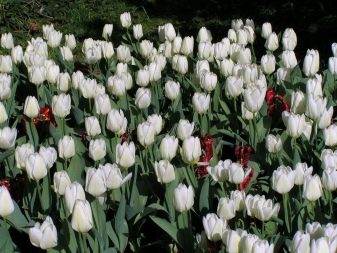
Fans of exoticism are crazy about flower beds with forest flowers - lilies of the valley, swimsuits, steppe tulips, anemones, snowdrops, violets. To emphasize harmony with nature, such flower beds can be "hidden" under trees, placed in the depths of the garden. Indeed, in this case, the place will correspond to the natural "dislocation" of the spring floristic object.
Admiring glances are always attracted by a flower bed in the form of an arabesque. This is a curly planting of flowers that creates a butterfly configuration.It requires great efforts from summer residents, but it always pays for their work with the unexpectedness and intricacy of fantasy solutions. The arabesque needs to be placed in the very center of the site, allowing the public to freely walk around this beautiful piece.
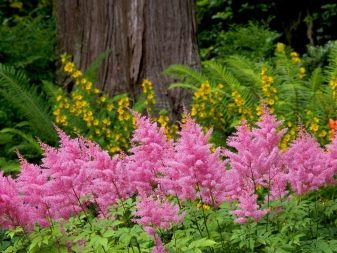
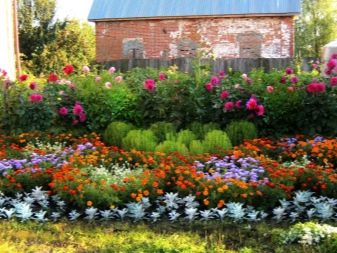
It is preferable to fill a butterfly flower garden with bright, similar to the shades of swallowtail wings, plants, while not particularly whimsical, since they have to grow quite densely. As an option - orange goldenrod, purple coneflower, blue cornflower, milk zinnia.
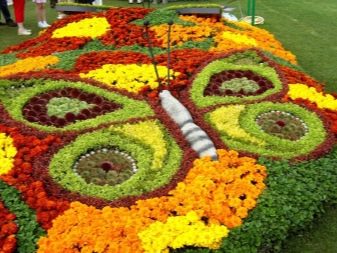
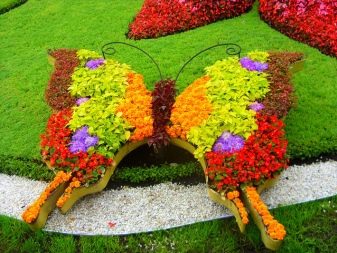
How to prepare?
To take into account all the features of the future flower bed and get real joy in the process of its creation, you have to take the following steps:
- Study the selected plants and understand whether they will survive in your climatic zone, whether the planting material you like is being sold, whether the seedlings will ruin you;
- Come up with a fence - wood, plastic, groove, etc .;
- Prepare the soil, apply fertilizers;
- Draw your own sketch, in which you take into account the plants in height and width;
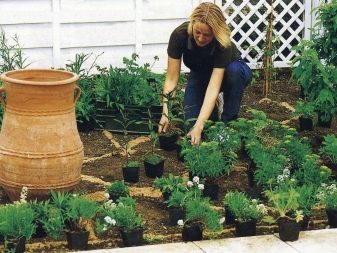
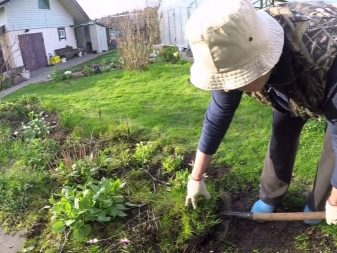
- Choose an approach to creating a flower garden so that it immediately looks beautiful or blooms in perspective; the density of planting seedlings depends on this decision;
- "Rehearse" the planting and harmony of colors by preliminary arrangement of pots with flowers in the area of the flower bed;
- Plant and water everything, then mulch the areas between young plants;
- Enjoy colors, rejoice in new buds, maintain comfort for flowers, shade them in extreme heat and feel the satisfaction that we create unique beauty with our own hands.

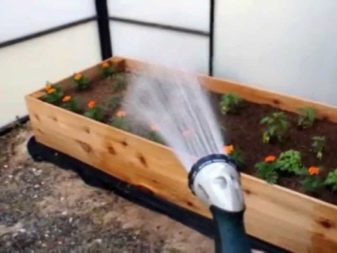
Planting plants
For a self-respecting gardener, this is not an easy task - planting plants. It is necessary to ensure that the flower bed does not spoil the site in any way, the color combinations on it do not turn out to be too faded or tastelessly variegated, so that the seedlings take root well and the plants bloom near the house for everyone's joy, without ceasing. Carried away by the upcoming creative work, try to fulfill the following plan:
- Conduct detailed planting planning, do not be lazy to draw up a flowering schedule by month. The correct approach is to open buds of at least three varieties of flowers in each period.

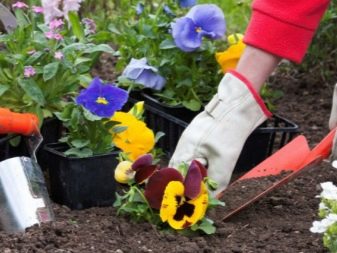
- Draw a diagram of where you will place which flowers. Pay special attention to the choice of the base of the fragrant structure - what will grow in the center, what will be around the perimeter, what will become the background. Experts advise the "soloists" to make several varieties - tulips for spring, poppies for early summer, roses for the peak of heat, chrysanthemums for autumn. Let them replace each other. Framing will look good from low-growing coniferous bushes. In the intervals of lush, stately plants, it is logical to provide for small background ones: sedum, mattiola, forget-me-not.

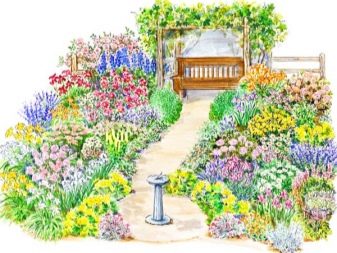
- Consider the grouping of plants. Leave the background for the large, skip the small ones in front. If the flower bed is round and equally viewed from all sides, then large flowers are present in the center. Broad-leaved specimens must be interspersed with narrow-leaved ones so that there is no dominance of too bulky greenery. The harmony of the green color would also be good to adjust - as the brightness increases from the center to the edges.
- Calculate how many pieces of each variety of seedlings a flower garden will require. Planting plants individually is a mistake. To provide a decorative effect, it is necessary to observe the "law" of homogeneous "arrays". It is permissible to plant one copy at a time, except that the conifers of the hosta and rogeria type.


The grammar of harmony in a flower garden is such - either a contrast, or an addition to one another. Although this rule does not at all pretend to completely neglect the personal coloristic joys of the owners of the dacha. Some people like red and blue. Although solutions of classic contrast are considered more sophisticated - for example, purple and yellow (Dutch tulips - swimsuit). Or the classic addition - yellow plus red plus orange (goldenrod, poppies, escholzia).Competently combine blue with pink and blue (cornflower with lavender, bell).
Florist designers are very much in favor of white in a flower bed - it softens contrasts and dilutes unnecessary heaps of color.

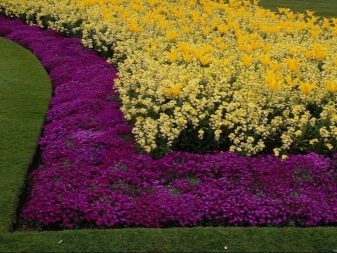
Before planting, the seedlings are properly spilled in the pot. A not sunny day is chosen, and early in the morning or in the evening, the landscapers begin to disembark. If you guess right and it rains, this will be an additional guarantee of the survival rate of the seedlings. A round flower bed begins to fill from the center, and flower beds at the fence - from the end.
The roots of the plants are gently straightened, the earth is compacted at the level of the neck. It is better to substitute sticks or other props for tall seedlings. Do not forget to water the “newborns” after finishing work.
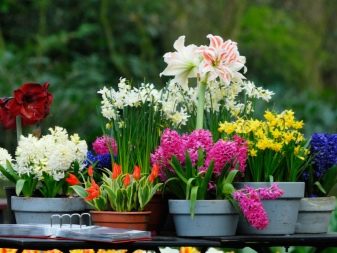
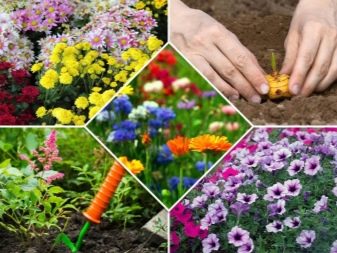
How to register?
There are a huge number of options on how to arrange and equip a flower bed with your own hands. For decades, the triangular flowerbed-cake has not lost its relevance. Or, more correctly, a slice of cake.
Several lily bushes are planted in a corner. Then, as the "piece" grows, there are silvery wormwood, burgundy korostavnik (6 bushes). The edges are decorated with 3 pieces of dark red heuchera. On the front, plant 5 cleaver bushes. The result is a very calm, "tasty" color background.

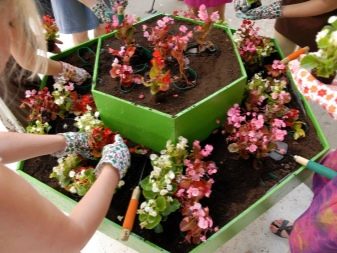
If there is no reservoir on your site, you can imitate it with a green-blue flower bed. The bed of the stream-flower garden is laid out with light pebbles. Add glass beads there, and you will have an even greater transparency effect. And "downstream" are planted bamboo, bearded iris, bell, tenacious, shaved, bruner, bryozoan. There is a delightful cool visual effect of plants near the water.
Car tires are a universal material for equipping a flower garden with the help of improvised means. If desired, funny crafts are obtained from them - fly agarics, brownies, bear cubs, swans. Soil is added inside and unpretentious flowers are planted. Plants do well in these conditions.
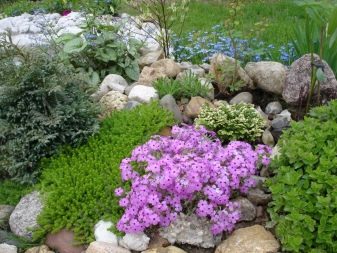

Aces of the device of intricate flower beds use old beds, chairs, plastic bottles, clay jugs for these purposes. This is not to say that such creativity delights absolutely all summer residents, but adherents of the country style, as well as owners of playgrounds, corners for kids, this exclusive pleases unspeakably!
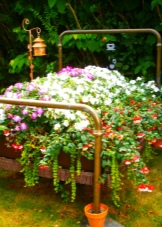
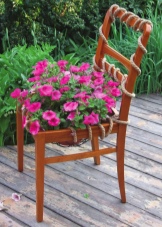
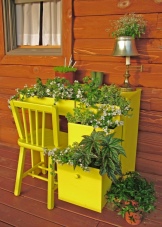
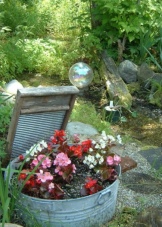
Design examples
We can talk endlessly about design ideas using colors. For example, a pond "drowned" in a flowerbed looks unique in the country. A border of flowers above the water can enchant the heart of any guest. No less enthusiasm will be caused by the "carpet path" made in an open space with the help of growing special roll lawns. Imagine how wonderful it will be for the whole family to relax in such a meadow.
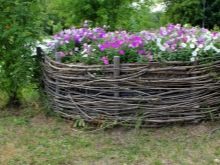
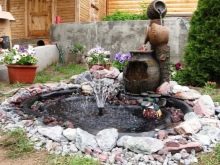

It is curious to build unusual stone flower beds near the house. Tall, catchy flowers such as cannes, ornamental sunflowers are placed in them. And nearby "scattered" for contrast, flower beds of naturally modest petunias or daisies. A scattering of stones will organically fit into the landscape landscape of the courtyard, among which bells and pansies will "get lost". Looks playful and attractive.
Experimental artists propose to build wooden sofas directly surrounded by climbing plants in order to rest, "immersed" in pollen almost completely. Such an area on the lawn is fenced off with a hedge or an artificial hedge.
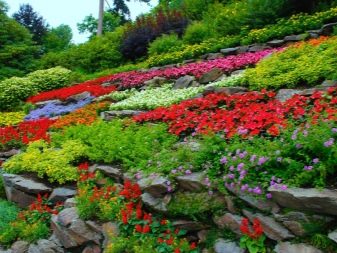
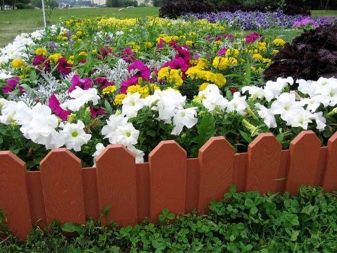
It is fashionable to illuminate flower beds with low lamps at night. And it is even more fashionable to “lose” bright yellows among the blue-green flowers - they will produce the effect of natural lanterns.
You can create a winding flower bed of dull flowers around a lonely spreading tree. Or you can "launch" curly roses on the arch, built of planks and suddenly appeared at the entrance.
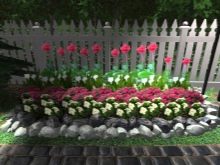
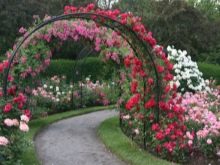
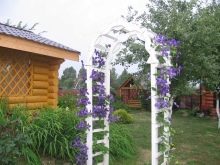
Recently, summer residents are increasingly using vegetable crops when laying out flower beds.Well-groomed bushes of lettuce, bell pepper, purple basil, purple cabbage fully meet not only decorative, but also culinary requirements. Landscapers achieve beautiful patterns by carefully arranging edible crops in a geometrically correct area.
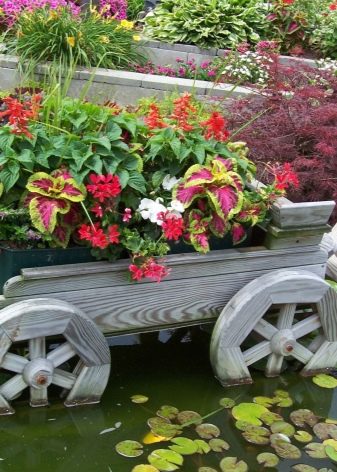
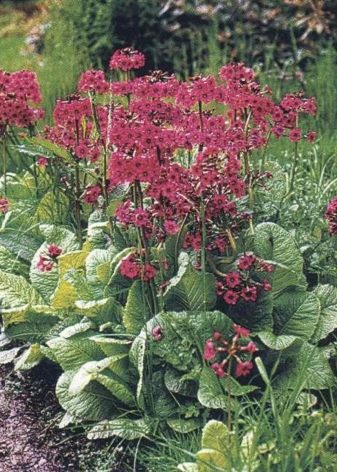
If you are drawn to the city again and again, if you start dreaming about your flower garden since winter, then you are captivated by this exciting creative task - to decorate your site with a flower bed of rare beauty and elegance. She will certainly convey your feelings and mood, because the plot of land where a person spends time of rest must be well-groomed and unique.
For information on how to design a new image of a flower bed, see the next video.







































































































The comment was sent successfully.